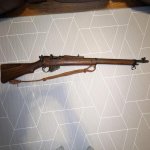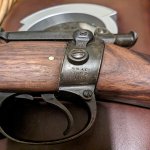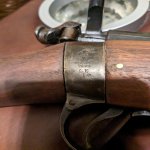You are using an out of date browser. It may not display this or other websites correctly.
You should upgrade or use an alternative browser.
You should upgrade or use an alternative browser.
Picture Thread - your earliest commonwealth milsurps
- Thread starter Claven2
- Start date
I'll play along, have a few Canadian issued oldies, nothing blackpowder though, never was a fan of those.
My oldest, a nicely M&D marked 1898 dated carbine, was reportedly carried by a member of the Canadian Army Medical Corp during the Second Boer War and not used much hence its very nice shape. Unfortunately i have no provenance, just the info from the previous owner who was the great nephew of the soldier in question.



This one is just a plain ole 1918 dated No1MK3, C broad arrow on the forend and a C broad arrow marked bayonet as well.



A couple of No4Mk1's, an early 3L 1942 example and a 7.62 DCRA conversion using a 1943 receiver.

And what Canadian collection is complete without a Cooey, this one is proofed 67, has an interesting sling with a makers mark from Toronto.



My oldest, a nicely M&D marked 1898 dated carbine, was reportedly carried by a member of the Canadian Army Medical Corp during the Second Boer War and not used much hence its very nice shape. Unfortunately i have no provenance, just the info from the previous owner who was the great nephew of the soldier in question.



This one is just a plain ole 1918 dated No1MK3, C broad arrow on the forend and a C broad arrow marked bayonet as well.



A couple of No4Mk1's, an early 3L 1942 example and a 7.62 DCRA conversion using a 1943 receiver.

And what Canadian collection is complete without a Cooey, this one is proofed 67, has an interesting sling with a makers mark from Toronto.



Last edited:
New stock, and the front band and volley sights are new reproduction.
Cool. Though my honest opinion is your stock needs a lot more hand linseed oil rubs, perhaps with some #0000 steel wool between coats to fill the pores and give it more of a service rifle Sheen
Edburns117
Member
- Location
- SW Ontario
Attachments
-
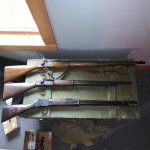 6FB0BE3E-7C21-492F-85DE-C9ECABDC13E5.jpg69.2 KB · Views: 284
6FB0BE3E-7C21-492F-85DE-C9ECABDC13E5.jpg69.2 KB · Views: 284 -
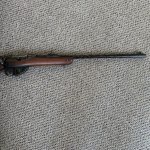 B36CE6EE-3FE6-442B-B77D-350298A4DA0F.jpg143.8 KB · Views: 285
B36CE6EE-3FE6-442B-B77D-350298A4DA0F.jpg143.8 KB · Views: 285 -
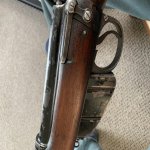 ECFF678C-12E2-4139-9996-CAD9DF0CEC88.jpg90.7 KB · Views: 285
ECFF678C-12E2-4139-9996-CAD9DF0CEC88.jpg90.7 KB · Views: 285 -
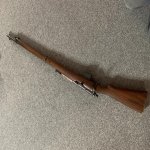 E2D81A34-DE39-4F3F-9332-4509B792161E.jpg138.8 KB · Views: 288
E2D81A34-DE39-4F3F-9332-4509B792161E.jpg138.8 KB · Views: 288 -
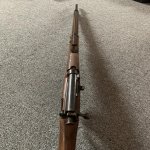 521F75FE-55EA-4DE2-A673-CBD8D9975FC6.jpg143.4 KB · Views: 286
521F75FE-55EA-4DE2-A673-CBD8D9975FC6.jpg143.4 KB · Views: 286 -
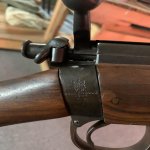 37E422D1-DB5D-4C00-87F1-C49A6824C5BB.jpg61 KB · Views: 284
37E422D1-DB5D-4C00-87F1-C49A6824C5BB.jpg61 KB · Views: 284
This is my earliest Canadian "milsurp" - London-made Model 1851 Colt "Navy" revolver:
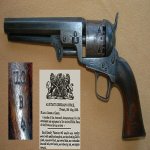
It is one of about 800 such revolvers acquired in Britain by the United Province of Canada in 1855/56 for issue to Troops of Volunteer Militia Cavalry. The butt markings denote that this revolver was issued in Upper Canada to "B" Troop (St. Catharines) as number 4 of the first 25 revolvers issued to that unit June 30, 1856. (A further issue of 25 revolvers was made to the unit January 5, 1857.)

It is one of about 800 such revolvers acquired in Britain by the United Province of Canada in 1855/56 for issue to Troops of Volunteer Militia Cavalry. The butt markings denote that this revolver was issued in Upper Canada to "B" Troop (St. Catharines) as number 4 of the first 25 revolvers issued to that unit June 30, 1856. (A further issue of 25 revolvers was made to the unit January 5, 1857.)
Attachments
This is my earliest Canadian "milsurp" - London-made Model 1851 Colt "Navy" revolver:
It is one of about 800 such revolvers acquired in Britain by the United Province of Canada in 1855/56 for issue to Troops of Volunteer Militia Cavalry. The butt markings denote that this revolver was issued in Upper Canada to "B" Troop (St. Catharines) as number 4 of the first 25 revolvers issued to that unit June 30, 1856. (A further issue of 25 revolvers was made to the unit January 5, 1857.)
Very nice Colt. What caliber is it in, .36 or .44 ?
Very nice Colt. What caliber is it in, .36 or .44 ?
upper and lower Canada colt 1851's were all in .36
Great thread, with some excellent goodies in it, so will add my earliest. I have found my collecting/shooting interests moving further back in history and searching for examples to acquire has been good fun. Here are some of mine. Love shooting them all.
First, and earliest, is this India Pattern Serjeant's Carbine Model 1797. Scaled down (.65/carbine calibre, shorter barrel etc.) from the full-size musket (Bess), to make life easier for the Serjeants.

1838 Sea Service pistol

2nd Model Pattern 1853 musket

1894-dated HRB Martini-Henry IC1 carbine, still in .577-450

And, lastly, 1915-dated WD-marked Webley Mk V.

First, and earliest, is this India Pattern Serjeant's Carbine Model 1797. Scaled down (.65/carbine calibre, shorter barrel etc.) from the full-size musket (Bess), to make life easier for the Serjeants.

1838 Sea Service pistol

2nd Model Pattern 1853 musket

1894-dated HRB Martini-Henry IC1 carbine, still in .577-450

And, lastly, 1915-dated WD-marked Webley Mk V.

Last edited:
thought I'd share a little info on vintage rolled brass foil martini cartridges. Yes, you heard right, the cartridges the British issued with the Martini Henry Mk1, MkII and MkIII rifles throughout their front line service life were not drawn brass. The were a rolled brass foil cartridge with a blued steel base plug. Some colonies, late in the service life of the Martini (well after it was relegated to a second class arm in the UK), did eventually adopt a drawn brass cartridge, but they are very uncommon in military loadings. Of course, all the commercial loadings available for these guns, mostly made available once they hit the surplus market from brands like Dominion and Kynoch, were drawn brass.
Here's a little photo to help explain what I'm talking about:

here you see, from BOTTOM to TOP:
1) a once-fired and reloaded(!) british issue cartridge from the 1870's. (more on that later)
2) an unfired issue cartridge from the 1870's (note the paper patch has disintegrated above the case mouth, but it once had one)
3) a very late issue (Canadian) drawn brass military cartridge (note most of the paper patch is disintegrated, but it also had one).
None of these has a headstamp. That wasn't done back then. Rounds were identified only by an ink stamp of the brown paper cartridge wrapper. But that does not mean they are not marked. Every rolled brass cartridge steel base had a brass primer liner pressed into it, and these were all broad arrow marked (see photo - sorry it's a bit blurry):

Also, British issue bullets were each individually broad-arrow marked on the bullet heel (!). When these were made, Canada, India, etc. all marked their ammo the same way - they were just British, even though Canada had technically become an independent commonwealth country a few years earlier in 1867. Of note, the broad arrow is cast in and is PROUD - not stamped into the bullet base. The base is also slightly convex to make room for the twister paper patch base, so the whole thing could sit flat against a waxed fiber wad card in the cartridge neck.
[/img]https://i.imgur.com/T8SaWNB.jpg[/IMG]
I've pulled the bullets from both drawn and rolled cartridges and the bullets are identical. They all weigh 480 grains and have two cannelures where the case mouths are crimped to the bullet (the drawn case mouth tip is crimped into a cannelure, vice the rolled brass that are crimped below the case mouth).
Here you can see the cannelures, the fiber wad in the casing, and what remains of the paper patch base on an original rolled brass round:

Now for the reloaded round...
I fired a few of these 1870's rolled bras rounds. They all functioned like new, even though some had rusty bases and pretty tarnished up casings. They even shot well and grouped decently at 100 yards (!). While I usually use either modern Jamieson cases, used dominion cases, or formed CBC 24 gauge brass cases, I thought it would be interesting to see of the fire formed rolled cases could be successfully reloaded and re-used. It turns out they can - and they work reasonably well, even for reloads. It's not easy though...
For starters, they are boxer primed, but not like a modern boxer primer. The original primers are 0.140" longer than modern ones, so the primer pockets are WAY too deep to use a modern primer without modification. I had to machine a brass insert 0.140" long by .140" wide and with a hole drilled through it the same diameter as the flash hole and then friction press it into the original primer pocket to take up the extra pocket length so a new primer would sit flush. This was done on the lathe.
Next, they can only take small pistol primers. Totally OK if using real black powder, but if you wanted to use black powder substitute, you'd need to find magnum small pistol primers, I think, for more reliable ignition.
In case anyone cares, I'm handloading a cast 440gn paper patched bullet for these. wheel weight alloy, .450" unpatched and .466" patched. They seem to shoot well in my MkIII. I'm also loading 70gns of Goex FFG, kapok topped, waxed cardboard wad, 1/4" beeswax and crisco lube cookie, another wad card, and the bullet. It's a little milder than the service round. The service loads (for rifles, not carbines) was a 480 gr bullet made of an alloy of 1 part tin and 12 parts lead, 85 gr RFG2 blackpowder, muzzle velocity of 1,300 to 1,350 ft/s.
Obviously, you can;t really full length size wrapped casings, so I just press the bullets into the reloads, - they are a finger pressure friction fit and are held in OK. I re-use these only in the gun that fired them originally - still, a fun project.
Here's a little photo to help explain what I'm talking about:

here you see, from BOTTOM to TOP:
1) a once-fired and reloaded(!) british issue cartridge from the 1870's. (more on that later)
2) an unfired issue cartridge from the 1870's (note the paper patch has disintegrated above the case mouth, but it once had one)
3) a very late issue (Canadian) drawn brass military cartridge (note most of the paper patch is disintegrated, but it also had one).
None of these has a headstamp. That wasn't done back then. Rounds were identified only by an ink stamp of the brown paper cartridge wrapper. But that does not mean they are not marked. Every rolled brass cartridge steel base had a brass primer liner pressed into it, and these were all broad arrow marked (see photo - sorry it's a bit blurry):

Also, British issue bullets were each individually broad-arrow marked on the bullet heel (!). When these were made, Canada, India, etc. all marked their ammo the same way - they were just British, even though Canada had technically become an independent commonwealth country a few years earlier in 1867. Of note, the broad arrow is cast in and is PROUD - not stamped into the bullet base. The base is also slightly convex to make room for the twister paper patch base, so the whole thing could sit flat against a waxed fiber wad card in the cartridge neck.
[/img]https://i.imgur.com/T8SaWNB.jpg[/IMG]
I've pulled the bullets from both drawn and rolled cartridges and the bullets are identical. They all weigh 480 grains and have two cannelures where the case mouths are crimped to the bullet (the drawn case mouth tip is crimped into a cannelure, vice the rolled brass that are crimped below the case mouth).
Here you can see the cannelures, the fiber wad in the casing, and what remains of the paper patch base on an original rolled brass round:

Now for the reloaded round...
I fired a few of these 1870's rolled bras rounds. They all functioned like new, even though some had rusty bases and pretty tarnished up casings. They even shot well and grouped decently at 100 yards (!). While I usually use either modern Jamieson cases, used dominion cases, or formed CBC 24 gauge brass cases, I thought it would be interesting to see of the fire formed rolled cases could be successfully reloaded and re-used. It turns out they can - and they work reasonably well, even for reloads. It's not easy though...
For starters, they are boxer primed, but not like a modern boxer primer. The original primers are 0.140" longer than modern ones, so the primer pockets are WAY too deep to use a modern primer without modification. I had to machine a brass insert 0.140" long by .140" wide and with a hole drilled through it the same diameter as the flash hole and then friction press it into the original primer pocket to take up the extra pocket length so a new primer would sit flush. This was done on the lathe.
Next, they can only take small pistol primers. Totally OK if using real black powder, but if you wanted to use black powder substitute, you'd need to find magnum small pistol primers, I think, for more reliable ignition.
In case anyone cares, I'm handloading a cast 440gn paper patched bullet for these. wheel weight alloy, .450" unpatched and .466" patched. They seem to shoot well in my MkIII. I'm also loading 70gns of Goex FFG, kapok topped, waxed cardboard wad, 1/4" beeswax and crisco lube cookie, another wad card, and the bullet. It's a little milder than the service round. The service loads (for rifles, not carbines) was a 480 gr bullet made of an alloy of 1 part tin and 12 parts lead, 85 gr RFG2 blackpowder, muzzle velocity of 1,300 to 1,350 ft/s.
Obviously, you can;t really full length size wrapped casings, so I just press the bullets into the reloads, - they are a finger pressure friction fit and are held in OK. I re-use these only in the gun that fired them originally - still, a fun project.
Last edited:




















































